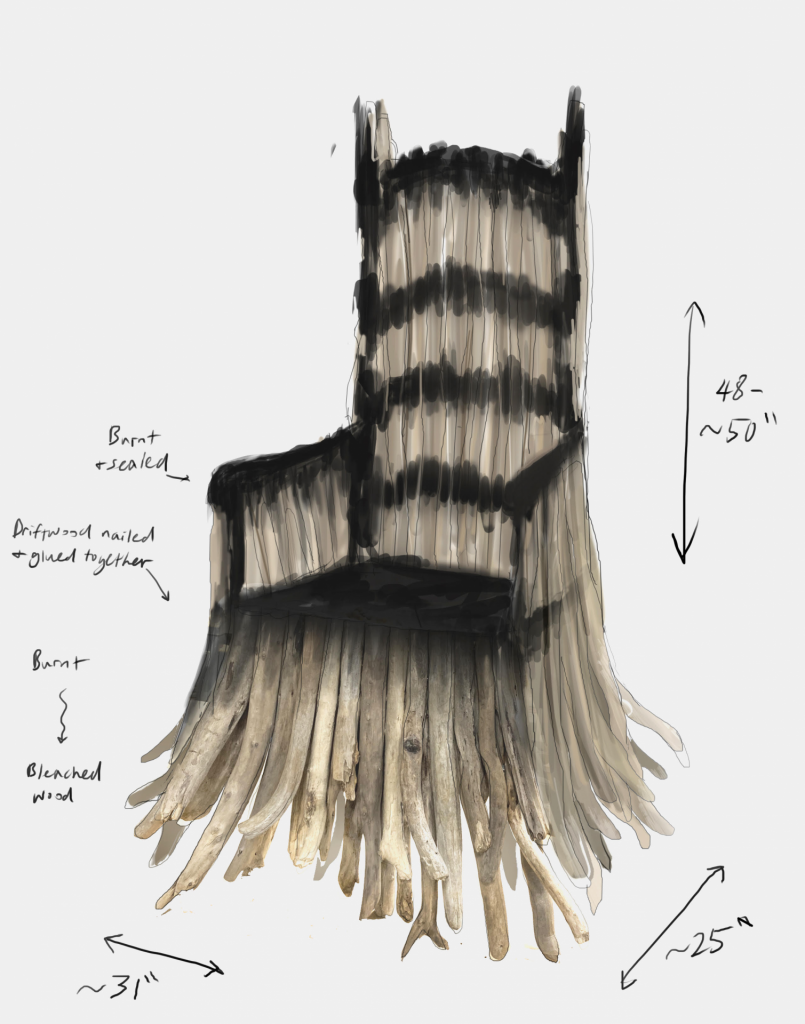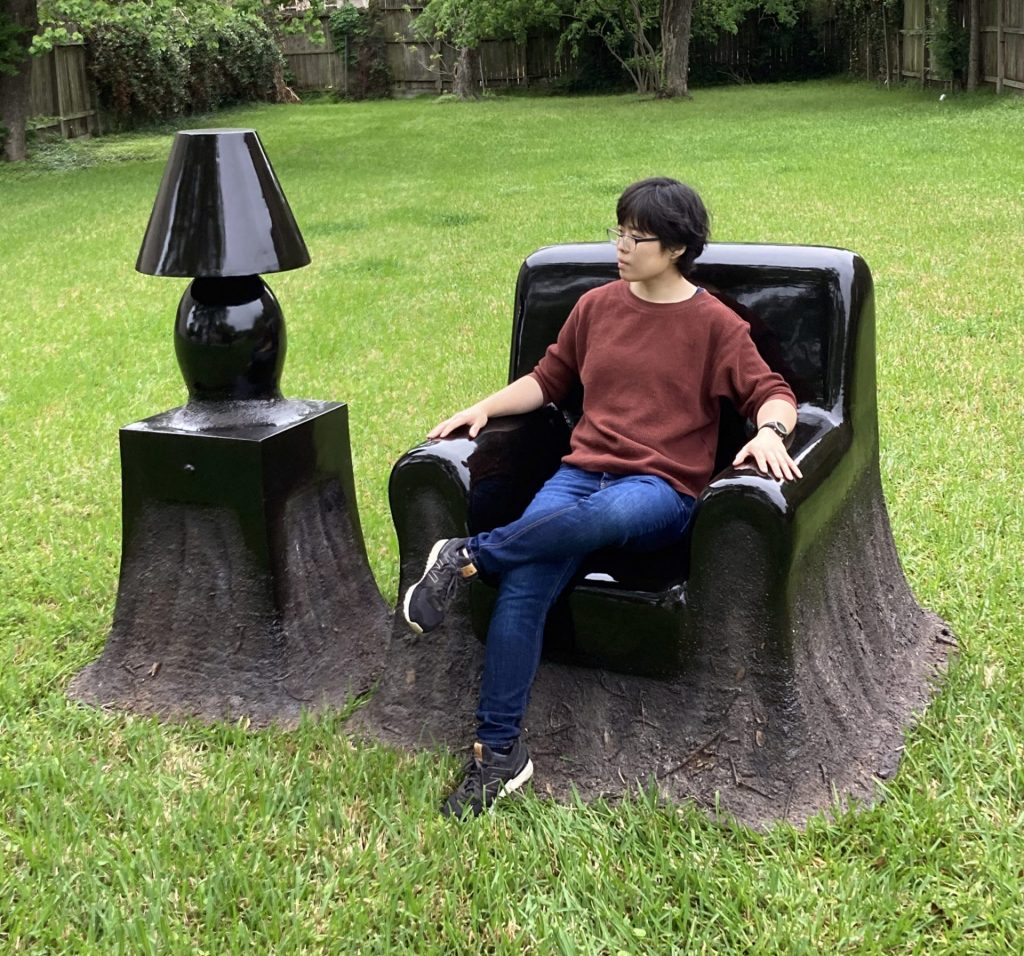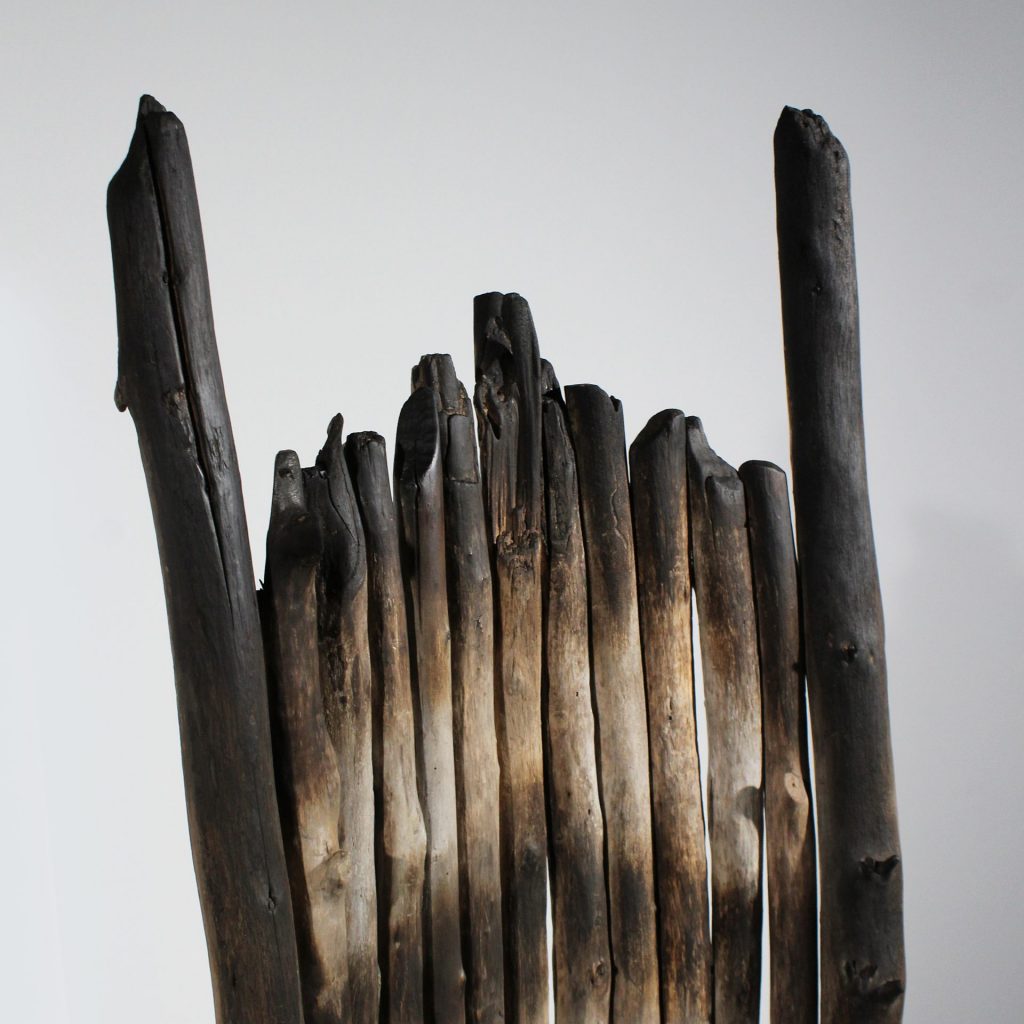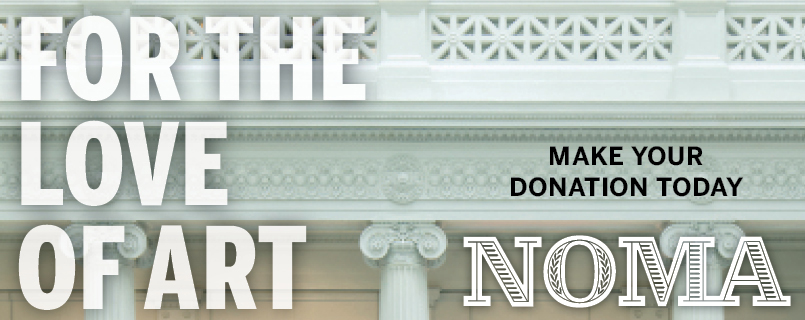
Joyce Lin (American, b. 1994), Ghostwood Chair and Table, 2022. Found driftwood, charcoal, burned & sealed with Danish oil; Chair 57 x 30 x 27 inches. New Orleans Museum of Art, Museum purchase, William McDonald Boles and Eva Carol Boles Fund and Gift of the Artist and R & Company, 2022.49.1,.2. Photo by Joyce Lin.
A powerful new voice in contemporary craft, Joyce Lin (American, b. 1994) makes work that is both conceptual and beautifully crafted. For her Ghostwood Chair and Table, commissioned by NOMA, Lin collected driftwood nearby in Louisiana’s Bayou Bienvenue Wetlands. The work’s title references a “ghost forest,” the geographical term for marshes where salty water has encroached into once-verdant swamp forests, leaving a landscape of poisoned trees. Suggesting a 19th-century Louisiana ladder back chair burned and inked onto the driftwood, Lin begins a conversation with Ghostwood about memories held within objects—and shows a contemporary concern about climate destruction—while maintaining an undeniable beauty even in a dark theme.
Lin grew up in Birmingham, Alabama, and graduated from the dual-degree program at Brown University and the Rhode Island School of Design. The artist now teaches at the TXRX Labs makerspace in Houston and makes work within the city’s East End Maker Hub. To share the layers of meaning in her work, Lin captured the process of creating Ghostwood Chair and Table on video and spoke with Mel Buchanan, NOMA’s RosaMary Curator of Decorative Arts and Design.
Joyce Lin and Weei-Chin lin, videographer, Ghostwood process video, 2022.
You traveled to New Orleans in November 2021 as you prepared to make this artwork with NOMA. Can you share more about your visit and what resonated?
I was really inspired by NOMA’s retrospective of New Orleans artist Dawn DeDeaux. The powerful multimedia work in Dawn DeDeaux: The Space Between Worlds showed a vision of mankind on the brink of collapse, plagued by pandemics, climate disasters, and social unrest. The exhibition was very dark in theme, yet I felt that the work was not necessarily depressing. At the time, I was already thinking about similarities between New Orleans and my current home of Houston in their recent history with catastrophic hurricanes and flooding. DeDeaux’s work forwarded my thinking about periods of transition and finding a kind of sublime beauty within destruction and loss.
While you were here, you explored natural areas around the city. Did you already have the idea for Ghostwood in mind, or did it come after visiting the swamp landscapes?
For this work, I knew that I wanted to use found material, but it wasn’t until my trip to Louisiana and learning about ghost forests through the museum exhibition that my interest in driftwood, or “ghost wood,” started to form. I visited the Bayou Bienvenue Wetlands to experience firsthand an actual ghost forest. These areas are not forests at all, but rather saltwater marshes that were once full of cypress trees. These particular forests were harmed by salty sea water after levee and canal construction beginning in the 1950s. I was haunted by what I saw, and the idea for Ghostwood took shape about a month later.

Joyce Lin, Sketch in preparation for Ghostwood Chair and Table, 2022.
You attended the Rhode Island School of Design to study furniture, but as part of a dual degree program with Brown University, where you also studied Geology and Biology. Can you tell us more about your ecological research that went into Ghostwood?
I read about various ecological topics including ghost forests, but also New Orleans social history and historical Louisiana furniture that used native woods, like cypress. Though ghost forests are found all over the coastal United States, the state of Louisiana experiences one of the most extreme rates of wetland loss. (The often quoted statistic from the U.S. Geological Survey is that a football field size of Louisiana wetlands vanishes into open water every 100 minutes.)

Joyce Lin sitting on her Home Grown, 2021, a work made of fiberglass, epoxy, and soil. The work was displayed on Houston’s Richmond Avenue Sculpture Trail April 24 to Dec 31, 2021. Photo by Weei-Chin Lin.
You’ve made other artwork that explores the fraught relationship between the natural world and manmade objects, like Home Grown. What is the underlying message you try to explore with this theme?
I’m fascinated by the creative (and destructive) capabilities of mankind, and I’m often jumping back and forth between materials that are considered natural (i.e., raw wood) and materials that are heavily engineered (i.e., plastics and sleek finishes). As much as we try to create objects that last, in the end everything succumbs to forces of time and physics beyond our control. Ghostwood is a reminder of this inevitability, in being an object shaped by water, desaturated by sun, and darkened by fire, in the shadowy form of previously existing furniture. Some might find it sad or anxiety-inducing, but I think the idea of transformation can also be beautiful and humbling.
Can you share the role that you think design thinkers and makers have in the face of existential human problems like climate destruction?
I try to be realistic about what designers can and can’t do when it comes to practical solutions. Designers are a lot of things, but we’re not scientists or politicians. If anything, our creative process is often resource-heavy and materially wasteful! We makers embody the human urge to manipulate our surroundings, for better or worse. Having said that, the problem of climate change and environmental degradation is cultural as much as technological. I hope that the thoughtful work of design thinkers can lead to a more interconnected, ecologically sensitive approach to the world.

Joyce Lin (American, b. 1994), Detail of Ghostwood Chair and Table, 2022. Found driftwood, charcoal, burned & sealed with Danish oil; Chair 57 x 30 x 27 inches. New Orleans Museum of Art, Museum purchase, William McDonald Boles and Eva Carol Boles Fund and Gift of the Artist and R & Company, 2022.49.1,.2. Photo by Joyce Lin.
Back down to earth, on the level of making, can you break down the materials and processes used to create Ghostwood?
I sourced the driftwood from the Gulf Coast and its tributaries, mostly near the mouth of the Brazos River in Freeport, Texas, and some I collected from New Orleans beside the Mississippi River. I picked out pieces with specific curvatures and thicknesses. I power washed the found wood before the laborious process of arranging, cutting, and shaping the chair and table form. It was assembled with glue and nails. I used a torch to burn the silhouette of a chair and table, taking inspiration from the wood ladderback chairs common to 19th-century Louisiana and the coastal South, though slightly exaggerated to appear more throne-like. Lastly, I did light touch ups with charcoal and sealed the burnt areas with Danish oil.
Is there a point where your conceptual ideas would have asked you to make something in one way, but technical limits (or desired aesthetics) meant you had to approach it differently in the workshop?
Yes, always! The fun challenge of making three-dimensional work is working with and sometimes subverting the physical limits of material. With Ghostwood, for example, there was no way to predict exactly how it was going to look. Every piece of driftwood is completely unique in shape, color, and texture. Even the wood density varied in relation to tree type and extent of weathering. This back and forth evolution between my mental concept of the project and material realities gives the final form to all my projects.

Installation view of Joyce Lin’s Ghostwood Chair and Table at the New Orleans Museum of Art.
Joyce Lin’s Ghostwood Chair and Table, 2022, are on view at the New Orleans Museum of Art in the second-floor Lupin Foundation Decorative Arts Galleries. The conversation above has been lightly edited for clarity and length.
NOMA is committed to uniting, inspiring, and engaging diverse communities and cultures through the arts—now more than ever. Your gift makes a direct and immediate impact as we plan exciting new exhibitions, organize insightful programs in the museum and Besthoff Sculpture Garden, and develop new ways for you to #ExploreNOMA.
